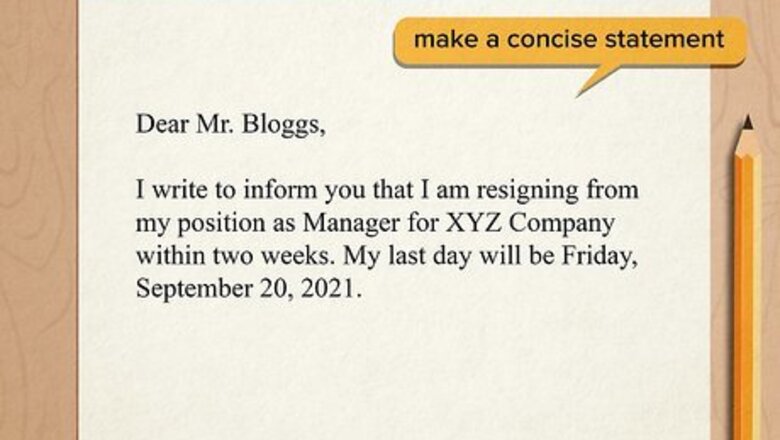
views
X
Expert Source
Alyson Garrido, PCCCareer Coach
Expert Interview. 24 January 2019.
Writing this notice letter can be intimidating, but it doesn't have to be. By formatting your letter properly and including all the right information, you can feel confident you're leaving your job on a good note.
Determining What to Say and How to Say It
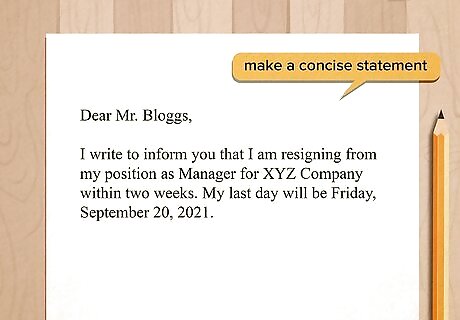
Make a clear and concise statement. The first line of your 2 weeks notice should clearly state that you are resigning from your position at the end of a 2 week period. Do not use wording that could suggest you would be willing to stay longer or change your mind with the right counteroffer. Good example: "This letter serves as an official notice of my resignation from [company name] as [job title], effective on [date of resignation]." Good example: "I hereby resign as [job title] at [company name], effective [date of resignation], two weeks from [current date]. Bad example: "I would like to quit from my position as [job title]. Please let me know what time frame would be most convenient for you." Bad example: "If all goes as I expect, I intend to resign from my position with the company two weeks from now."
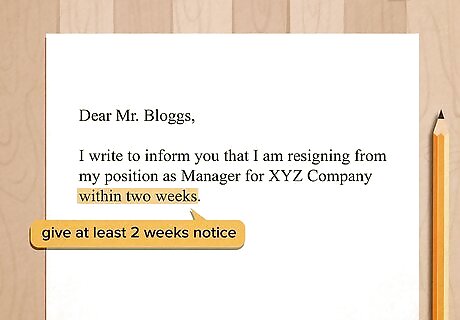
Give your employer at least 2 weeks. Nowadays, many employees are not contractually required to submit a resignation 2 weeks in advance, but doing so is still considered to be a professional courtesy. If you quit sooner than 2 weeks, future or prospective employers may wonder if you would do the same to them. If your company is currently entering an especially busy period, you may want to consider giving a “4 weeks notice” instead of only giving 2. Senior executives and other employees further up the food chain should consider giving more than 2 weeks, as well. As a general rule, provide an amount of time equal to the amount of vacation time allotted to your position. For instance, if your position grants you 3 weeks of vacation, give a "3 weeks notice" instead.

Be diplomatic if you choose to state your reasons for leaving. This is especially true if your reasons are somewhat volatile in nature, in which case it may be best to avoid stating them altogether. No matter how frustrated and disenchanted you are with the company, your 2 weeks notice letter is not an appropriate place to vent about it. Keep it brief, general, and professional. Unless you are asked to state your reasons for leaving in your official letter, you don’t necessarily need to include them at all. It might be a good idea to state your reasons for leaving if you are interested in applying for another position within the same company at some point, since this can help HR determine your eligibility for rehire. Prepare a reason to share when your supervisors and co-workers inevitably ask why you plan to quit. This reason does not need to be included in your official letter, but it is still practical to have when asked in person.
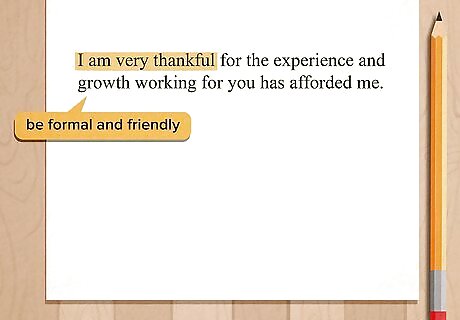
Be both formal and friendly. The overall tone of your 2 weeks notice should be professional, but not so professional that you come across as being cold or stiff. Typically, you should write the letter using the friendliest tone you have used with your employer in the past. If communications with your boss have always followed a rigid, professional structure, then continue that tone into your 2 weeks notice. On the other hand, if you communicate with your boss in a more personal manner, do not be afraid to take a more personal tone. A personal tone can be appropriate as long as it is not casual and sloppy. Good example: “I am very thankful for the experience and growth working for you has afforded me.” Bad example: “I formally state, for the record, that I continue to maintain high regard for ABC Company and hold no ill intent toward any employer or employee at the company.” Bad example: “Thanks 4 everything!”

Set a positive tone. This letter will be the last document in your personnel folder, so it needs to leave a good impression. Even if you hate the job you are quitting and want nothing to do with anyone at the company ever again, you still need to leave the bridge intact instead of burning it down. If a future prospective employer calls your former employer, hearing that you left a positive 2 weeks notice will make you look good. It is also beneficial in case the employee at your old company responsible for pulling your file knows nothing else about you. Never trash anyone at the company or criticize the way the company is run in your 2 weeks notice.
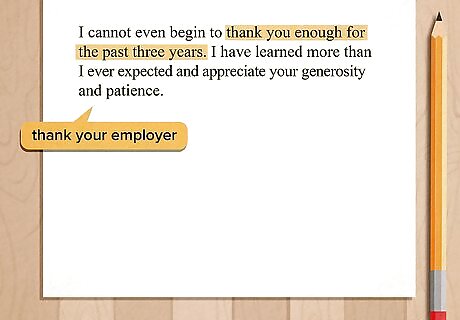
Thank your employer. Include a line or 2 thanking your employer for providing the opportunities and experiences you received by working for the company. Each job contributes something to a person's life, even if the cons largely outweigh the pros. If your working experience was mostly positive, make sure that your gratitude shows. Write something along the lines of, “I cannot even begin to thank you enough for the past three years. I have learned more than I ever expected and appreciate your generosity and patience." If your working experience was mostly negative, offer a general token of gratitude. Try something along the lines of, “I would also like to thank you for providing me with the experience I received over the past three years of employment.”
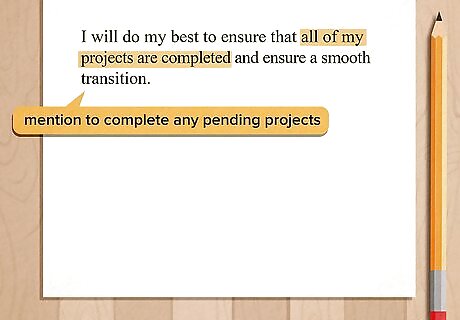
Let your employer know that you intend to finish any major projects. As a final act of responsibility and loyalty, you should note any pending projects or current projects that could collapse without your assistance and pledge that you will finish those projects instead of leaving the company in the lurch. Ongoing projects and minor projects that can be handled easily by someone else can be excluded from this. This leaves your employer with a good impression, thereby making it more likely that he or she will be willing to provide a good recommendation to another employer in the future when asked.
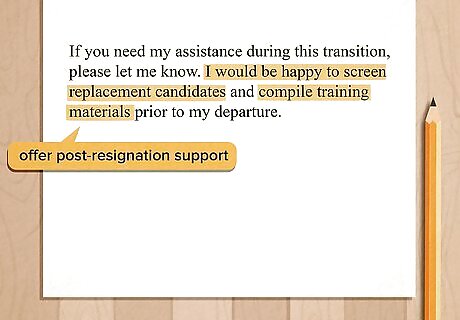
Offer your post-resignation support. As the company transitions into a different work flow after you leave, there are bound to be a few rocky patches. In your 2 weeks notice, offer to help the company make the transition even after your employment with them ends. Provide a phone number and/or e-mail address that the company can use to contact you if any questions come up.
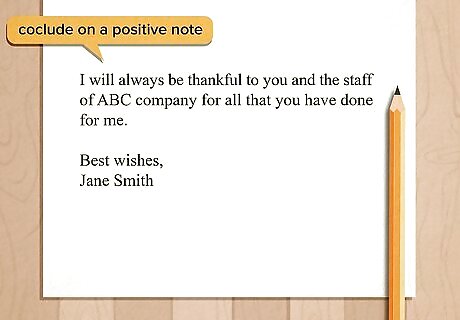
Close on a complimentary note. Even if you already thanked your employer earlier in the notice, it is a wise idea to close the body of your letter by restating your gratitude. Example: “I will always be thankful to you and the staff of ABC company for all that you have done for me."
Formatting the Letter
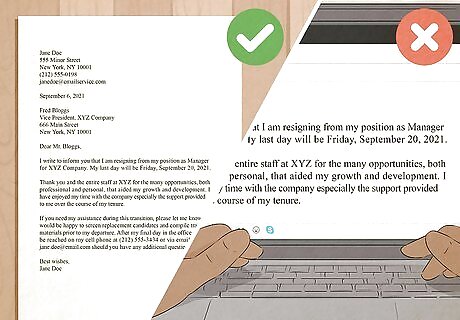
Write a letter, not an e-mail. When submitting your 2 weeks notice, you should write it as an actual typed and printed letter rather than an e-mail. This letter should be handed over to your boss in person. While writing an e-mail may seem easier and quicker, it is generally considered less professional and will usually be frowned upon. Do not mail your 2 weeks notice through the postal system or through your office mail system. Doing so may cause a delay, and by the time your employer gets your notice, your 2 weeks may already be halfway finished.
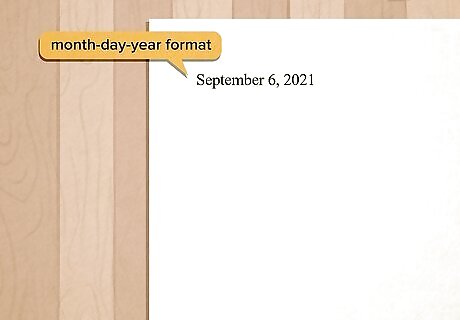
Type the date in the upper left corner. Per standard rules for writing a formal letter, you should type the date in month-day-year format in the upper left corner of the page. The month should be spelled out, but the day and year should be in numerical format. Example: June 26, 2013 Note that you do not usually need to include a return address above the date since your address would be the same as your employer's address. You can, however, use company letterhead with the address on it if you choose to.
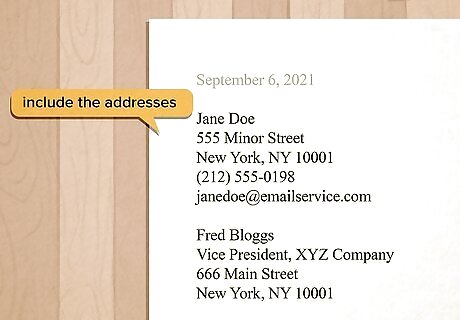
Consider including an inside address. If you are using company letterhead, you may opt to skip the inside recipient's address, as well, since this is a letter sent from within a single company. Including the address is a good idea, however, since it allows you to address the letter specifically to your boss. Include your employer's personal title and full name on the first line. Write the street address on the following line and the city, state, and zip code on the line after that. Skip a line in between the date and the inside address. Skip another line in between the inside address and the salutation that follows it. The address itself should be single-spaced, though.
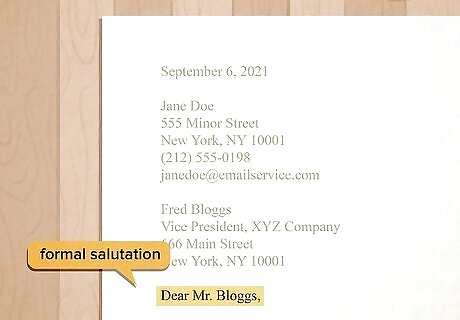
Address your employer directly in the salutation. Your letter should open with “Dear (boss's name).” Never use a vague or general salutation like “To Whom It May Concern.” Address your boss in the same way you usually do, even if that method is fairly casual. For instance, if you are on a first name basis with your boss, write “Dear Jennifer.” If you are only on a professional, last name basis with your boss, stick with “Dear Ms. Smith.”

Write the body of your notice. Skip a line after your salutation before you begin writing the body of your letter. Each body paragraph should be single-spaced, but there should be a blank line in between each separate paragraph. None of the paragraphs need to be indented. Keep your letter down to a single page at maximum.
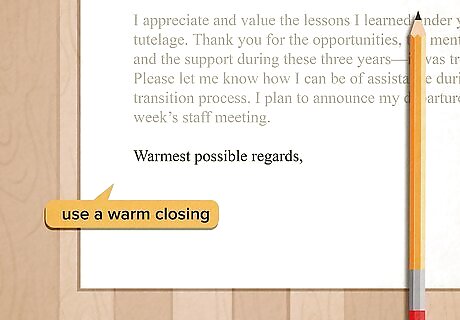
Use a warm closing. In order to maintain a friendly, positive tone, you need to offer a closing that seems a little warmer and more sincere than the usual “Regards,” “Thanks,” or “Sincerely.” A few examples of possible closings include: Warmest possible regards Best wishes for your continued success Warmest thanks for everything through now With sincerest gratitude and warmest wishes
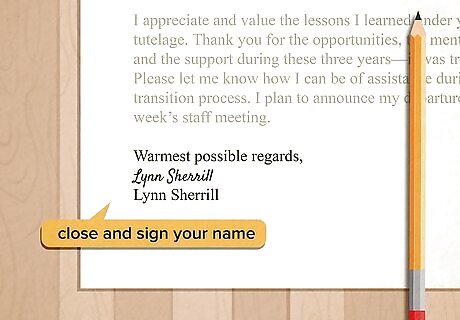
Type and sign your name. Type your full name 4 lines below your closing and sign your name in between the closing and the typed name.
Turning In Your 2 Weeks Notice
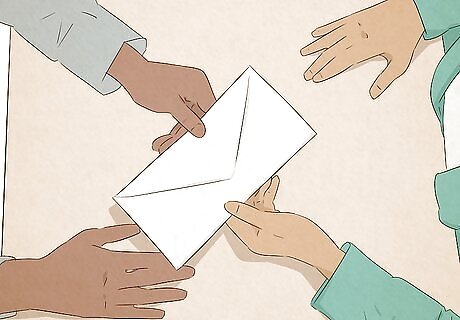
Take your 2 weeks notice directly to your boss. The most professional move to make is to hand your 2 weeks notice to your boss first and in person. You will usually need to schedule a meeting, but if you work at a small company and are on close terms with your boss, you might be able to drop by his or her office unannounced. Close the door behind you as you enter to keep the conversation private. Hand your boss your 2 weeks notice and explain, as you hand it over, what the letter is. Your boss will likely want to discuss the situation with you. Even if your letter already answers the questions posed to you, answer each question completely. Thank your boss as you leave the office and shake hands.
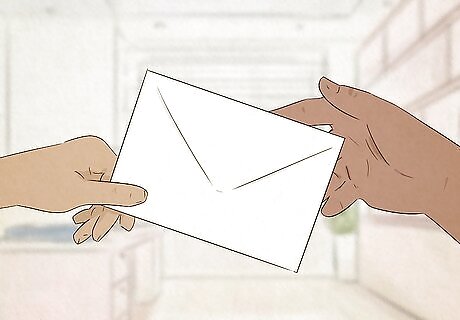
Submit copies to anyone else who may need one. This can vary by company, but usually, the Human Resources department will need a copy as well as any other supervisors you work under. If you do send the letter to multiple people, include a “CC” line indicating who has received a copy. This can help facilitate communication and coordination as your company deals with your resignation. Co-workers, mentors, team members, and clients should be told in person about your resignation. They do not need an official copy of your 2 weeks notice.

Work hard and tie up loose ends. If you offered to finish up any major projects before leaving when you wrote your letter, you need to follow through and finish those projects. Even if you did not make any promises, you cannot slack off during your final 2 weeks of employment. The transition will be difficult for everyone, and it is your professional duty to make that transition as smooth as possible for the employer you are leaving. Don’t let your company take advantage of you by asking you to do work well beyond the scope of your normal duties in your remaining 2 weeks. Stay polite and professional, but be firm about which tasks you will be completing before you leave.
















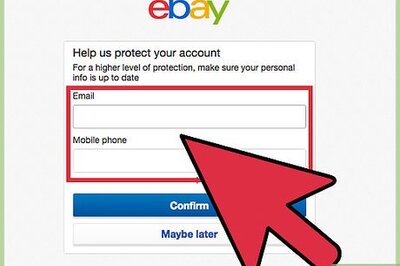


Comments
0 comment